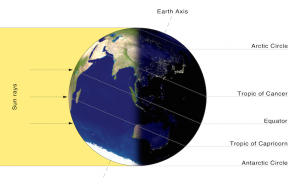Title
Weird Science: Seasons
NGSS Crosscutting Concepts
NGSS Disciplinary Core Ideas
It may seem strange that the northern hemisphere is closer to the sun during the winter and farther away during summer! However, the seasons are determined primarily by the tilt of the earth, not the distance between the earth and the sun. The earth is tilted on its axis approximately 23.5˚ relative to its orbital plane around the sun. When a hemisphere is tilted toward the sun, that hemisphere receives more direct sunlight and experiences summer. At the same time, the other hemisphere is tilted away from the sun and receives less direct sunlight, experiencing winter. The northern hemisphere is more directly exposed to the sun’s rays during June and July (summer in the northern hemisphere, SF Fig. 6.11 A). The southern hemisphere receives less direct sunlight during these months, resulting in winter. Exposure to direct sunlight alternates as the earth revolves in its orbit around the sun. The southern hemisphere is most directly exposed to the sun’s rays in December and January (SF Fig. 6.11 B). During this time the northern hemisphere experiences winter as it is receiving indirect sunlight.
SF Fig. 6.11. (A) In June, the northern hemisphere is experiencing summer and the southern hemisphere is experiencing winter because the northern hemisphere is more directly exposed to the sun’s rays.
Images courtesy of Przemyslaw "Blueshade" Idzkiewicz, Wikimedia Commons
SF Fig. 6.11. (B) In December, the northern hemisphere is experiencing winter and the southern hemisphere is experiencing summer because the southern hemisphere is more directly exposed to the sun’s rays.
Images courtesy of Przemyslaw "Blueshade" Idzkiewicz, Wikimedia Commons
Even though the tilt of the earth is responsible for the seasons, the elliptical orbit of the earth moderates the northern hemisphere's winters and summers. This means the temperatures of the northern hemisphere’s winters and summers are not as extreme as could be. In the southern hemisphere, the opposite effect occurs, with more extreme winters and summers.









